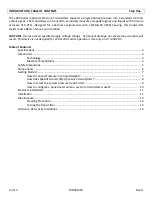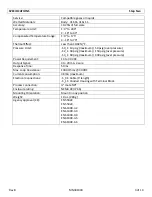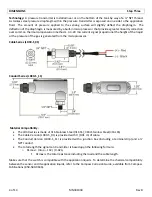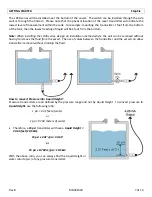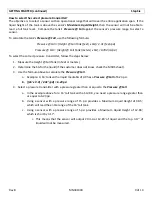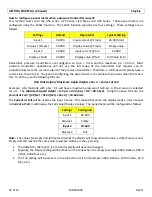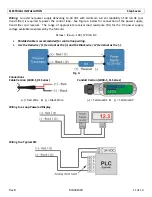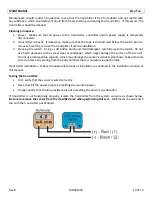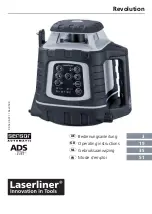
8
of
14
MN301030
Rev
B
GETTING
STARTED
(continued)
Step
Six
How
does
Specific
Gravity
affect
pressure
transmitters?
The
Specific
Gravity
(SG)
of
a
liquid
will
not
change
the
pressure
of
the
transmitter,
but
will
affect
how
the
transmitter
reads
the
liquid
height.
Remember,
liquids
with
a
SQ
<
1.0
are
lighter
than
water
and
liquids
with
a
SG
>
1.0
are
heavier
than
water.
Water
has
a
SG
=
1.0.
A
SG
<
1.0
requires
more
liquid
(a
taller
water
column)
to
equal
the
same
pressure
as
with
water.
A
SG
>
1.0
requires
less
liquid
(shorter
water
column)
to
equal
the
same
pressure
as
with
water.
SG
=
0.9
SG
=
1.0
SG
=
1.2
To
calculate
the
Maximum
Liquid
Height
of
a
sensor,
use
the
following
formula:
Maximum
Liquid
Height
(feet)
=
(Pressure
Range
x
2.31)
/
SG
Maximum
Liquid
Height
(meters)
=
(Pressure
Range
x
0.704)
/
SG
Example:
15
psi
transmitter
installed
in
a
liquid
with
a
SG=0.9
will
have
a
Maximum
Liquid
Height
=
38.5
feet
(11.73
m)
or
[(15
psi
x
2.31’/psi)/
0.9
=
38.5’]
.
Note:
The
above
formula
will
always
provide
the
Maximum
Liquid
Height
for
any
pressure
transmitter.
Example:
Compare
the
Maximum
Liquid
Height
of
a
liquid
with
a
SG
=
0.9
to
one
with
a
SG
=
1.0.
SG
=
0.9:
a
15
psi
transmitter
will
have
a
Maximum
Liquid
Height
=
38.5’
(11.73
m)
SG
=
1.0:
a
15
psi
transmitter
will
have
a
Maximum
Liquid
Height
=
34.65’
(10.56
m)
A
change
in
SG
of
0.1
will
increase
the
Maximum
Liquid
Height
of
a
transmitter
by
3.83’
(1.2
m)
.
Thus,
when
the
Specific
Gravity
is
less
than
1.0,
the
Maximum
Liquid
Height
of
the
transmitter
will
increase.
The
reverse
is
true
by
increasing
the
Specific
Gravity.
With
a
SG
=
1.2,
the
Maximum
Liquid
Height
=
28.88’
(8.80
m)
with
a
15
psi
transmitter.
Maximum
Liquid
Height
(28.88’)
=
(Pressure
Range
(15
psi)
x
2.31)
/
SG
(1.2)
Compare
to
a
liquid
with
a
SG
=
1.0,
the
Maximum
Liquid
Height
will
decrease
by
5.77’
(1.8
m).
When
the
Specific
Gravity
is
greater
than
1.0,
the
Maximum
Liquid
Height
of
the
transmitter
will
decrease.
Note:
Identifying
the
correct
specific
gravity
for
the
fluid
is
critical
in
understanding
the
operational
range
of
the
pressure
transmitter.


